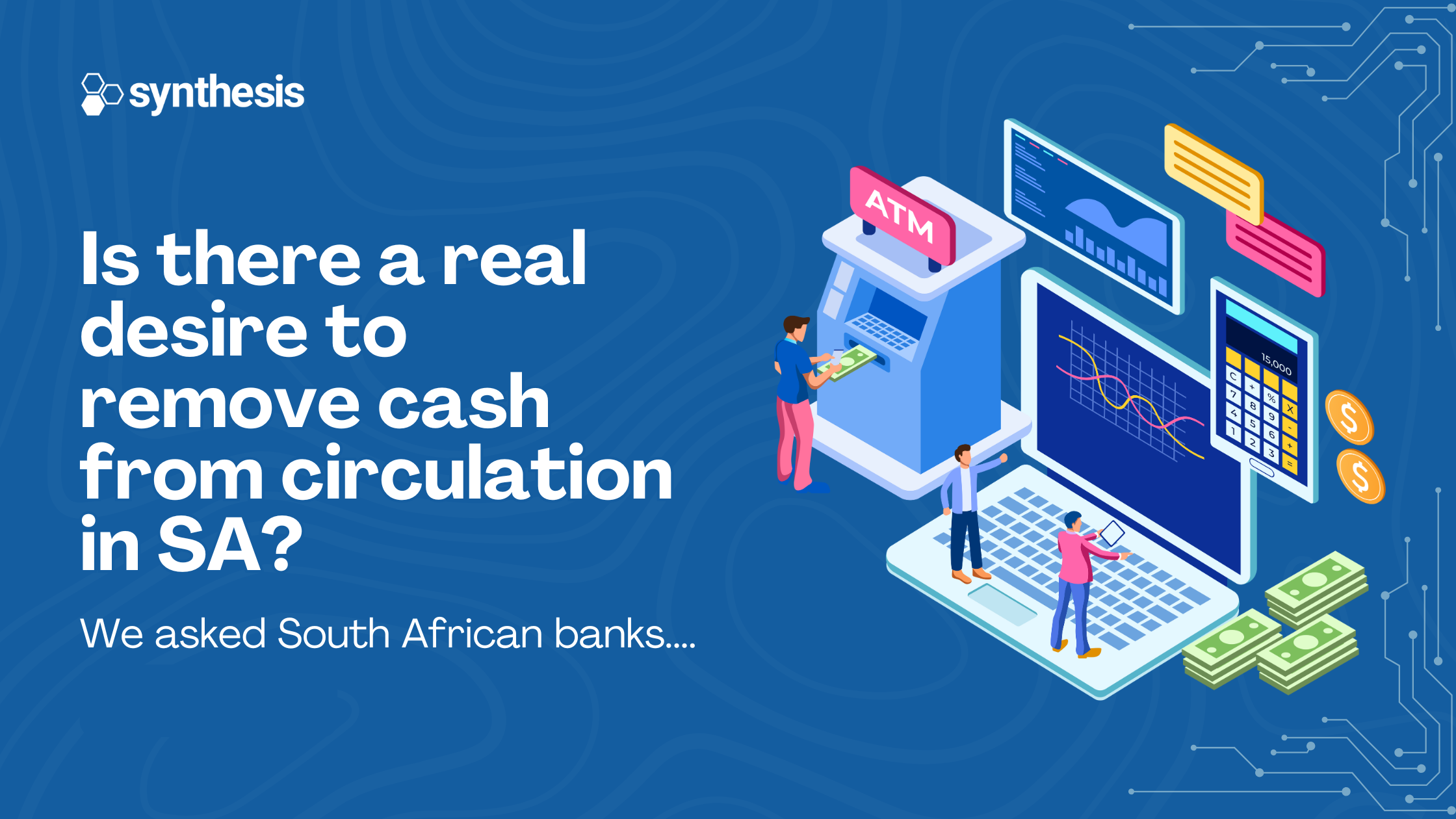Majority of South Africans are still using cash.
South African Reserve Bank’s recent report shows that cash is still the most prevalent payment method.
On the 10th of October 2024, Synthesis, a leading software development company, invited Financial Institutions and FinTech’s to engage in an insightful discussion on the future of payments for South Africa. This round table consisted of leading CIO’s, Head of Payments, decision makers, and Payment Specialists across the Banking and Financial Services industry, where these individuals got the opportunity to engage directly with a representative of the South African Reserve Bank (SARB).
Moderated by Howard Feldman, the discussion addressed topics related to payment modernisation by tapping into Brazil and India’s real time payment journeys, and, addressing SARB’s vision for South Africa and Regulations.
What are other countries doing?
In Brazil, the real time payments system is Pix. “Pix is a payment method developed, regulated, and supervised by the Central Bank of Brazil that enables transactions to occur in less than 10 seconds, 24/7 including weekends and holidays. Pix allows for real time exchange of value between parties, enabling financial inclusion through digitalisation, entrepreneurship for small businesses, infrastructure cost reduction for financial institutions, risk management, and tax collection”, explains Fabio Cossini, AWS Business Development Leader FSI.
In India, there has been evident growth in real-time payments. “Unified Payments Interface (UPI) is an Indian instant payment system and protocol developed by the National Payments Corporation of India. The motivating factors for UPI adoption in commercial banks in India include access to merchant ecosystems, additional income sources, cost savings, and revenue-generating products”, explains Arun Ramprasadh Head of UPI at Juspay and Aditya Kulkarni, Head of Payment Aggregation Business at Juspay.
SARB and participants acknowledged that South Africa is behind the rest of the world.
Payment Modernisation Considering SARB’s 2030 Vision
Giving the country the ability to transact digitally, and a fair access to financial services to all South Africans irrespective of their demographics and living standard measure. SARB wants to make the exchange of digital payments equal to the exchange of physical cash. “For example, when transacting with cash, if an individual had to purchase an item from a merchant with R20, the transfer of the value of R20 is immediate to the merchant without deduction of any fee When making transfers digitally, an individual or the merchant would need to pay for bank charges/scheme fee that are additional to the R20 transfer they are already making. For the program to succeed and lead to economic benefits, the ecosystem will need to come together and play its roles effectively”, explains SARB Representative.
Some challenges in achieving this goal in South Africa include a lack of financial awareness, affordable fast payment services, alternatives to cash, and foundational capabilities e.g. digital financial identity, eKYC, competition, and innovation in payments.
“For the program to succeed and lead to economic benefits, the ecosystem will need to come together and play its roles effectively”, says Mellanie De Jager, Programme Delivery Director for the SARB’s Payments Ecosystem Modernisation Programme.
What are the barriers to the adoption of real-time payments?
Why is adoption so low?
Quoted directly from Bank Representatives.
Gender Parity
The South African gender parity is a challenge as a large portion of the female population that live in the rural areas and manage their households do not have the necessary education or are not aware of these payment methods, hence the reliance on physical payment methods.
Trust
Building trust with the consumer is important to aid in adoption. Education needs to come from the banks, preferably, because the trust of the consumer is generally with the banks.
Trust
Contact crime in South Africa is one of the biggest challenges and therefore, banks are looking for ways to use AI to track behavioural patterns as a form of tracking crime.
Research
Research on optimisation and UPI needs to be conducted to support the vision. Demonstration or registration drives are essential and will aid in adoption.
What should SARB and other regulators do to encourage innovation without creating more obstructions?
Quoted directly from Bank Representatives.
The consideration of volume and “free” transactions are really important. As much as banks would like to create this cost-free option for consumers, there is a cost to build and maintain the technical infrastructure to enable digital payments. This is the purpose of bank charges. If the bank charges are removed, the merchant/bank will suffer the cost in the ecosystem.
Given that the program is focused on a long-term goal, SARB should consider ways to assist banks with the short-term impact of the regulations and investment in consumer behaviour change. Banks have funded the penetration of digital apps to customers and build the infrastructure. The challenge that is faced with the new regulations is convincing investors who are commercial focused.
Partnerships with banks and FinTechs are forming to potentially meet regulation with innovation. This has resulted in collaboration and opportunities for cross selling, cross acquisitions, and launching new CVPs.
AWS partners with companies like Synthesis to solve the biggest pain points in the industry, as a hyper scaler and an AWS Premier Tier Status Partner. “The aim is to take care of the time to market and value, address how companies adopt payment technologies, modernise payment systems, identify what prevents customers from adapting payment technologies and rapid payments adoption, which is the big move to real-time payments”, says Alfred Mukudu, AWS Financial Services Go to Market Lead”.
What do participants expect from SARB to foster collaboration rather than division?
FinTech Innovation is looking to de-cash wallets, micro merchant, etc. It is easier for FinTech’s to plug into financial services ecosystems. The downward trend is happening, SARB needs to drive this without over regulating processes, unnecessarily increasing costs and creating a competitive environment. The new regulations have resulted in a lot of additional costs for banks.
Economics of the model needs to make sense for all participants. Immediate reality of the regulations (the co-existence of cash and cashless). Education and awareness is really important not only to educate the consumers but also the merchants (banks). Creating uniformity across banking apps that also speaks to user experience and making education /awareness simpler.
Response from SARB
SARB is trying to create a self-sovereign South Africa. Creating an alternative network, that is safe and secure which allows to broaden the payment ecosystem and enables market competition. This network will allow FinTechs and other designated players to participate in the clearing and settlement without needing specific sponsorship from banks.
SARB wants to create regulatory frameworks so that it makes it easier to comply and establish a public payments utility which can be used by ecosystem players to build new business models and innovative solutions on. Defining strategy and vision 2023+ for the banks will result in currency management to help with the supply chain.
SARB states that Physical cash is still more costly due to manufacturing, distribution, theft and supply chain costs. No advocation for cash is free, but it’s about user experience for consumers to make payments without additional costs and for consumers to adopt more to digital payment methods. SARB will make the initial investment towards central infrastructure to make the systems reliable and accessible.
Charging individuals for low value transactions, the adoption to digital/cashless will not progress as fast. We believe that the market will find ways to balance the cost of innovation. Educating and awareness would need to work very closely with the industry. Exploring various education options to educate the low-income areas on how to use these payment methods. SARB is also looking to provide a consistent User Interface (UI) and a simple platform for the enabler (Bank) to communicate to consumers that it is faster, cheaper, and easier.
What’s the dream?
The dream is shared across all players in the ecosystem, merchants (Banks), regulators (SARB) and FinTechs, to see payments in South Africa see success.
To see the digitalisation of payments grow through innovation.
“With power comes responsibility, the responsibility to make South Africa a powerhouse at a global stage. We need to do this by asking difficult questions, engaging with each other, working together, and advancing how we make payments for all South Africans”, says Harsha Maloo, Head of Payments Synthesis.






